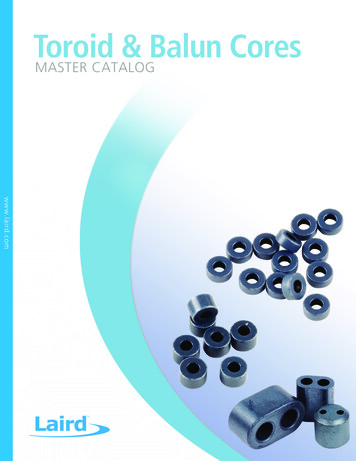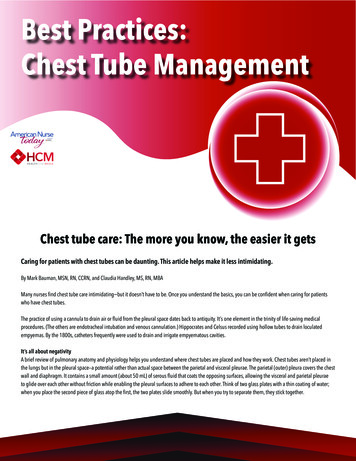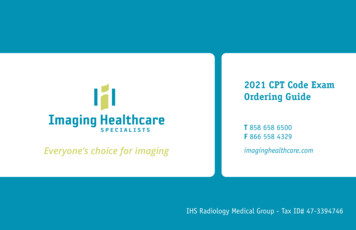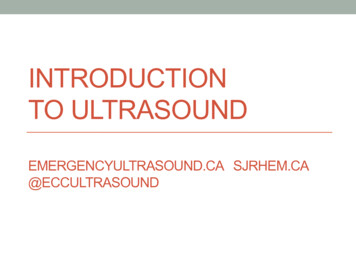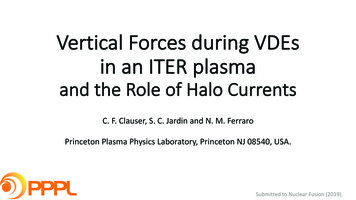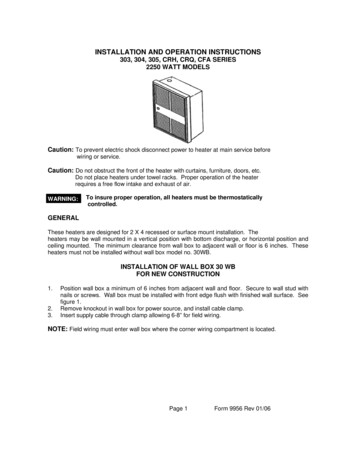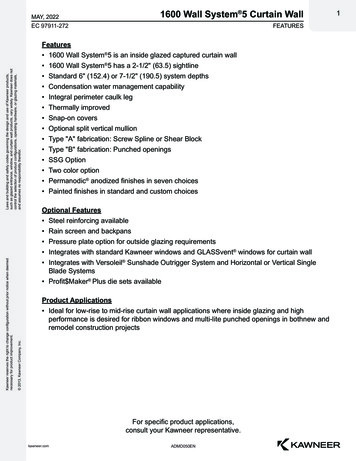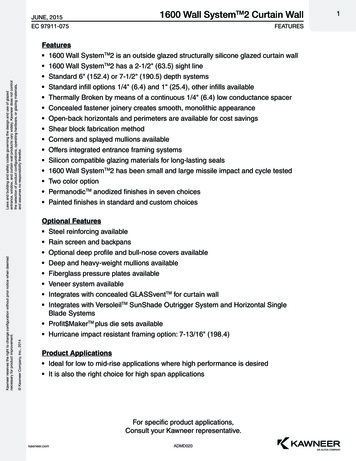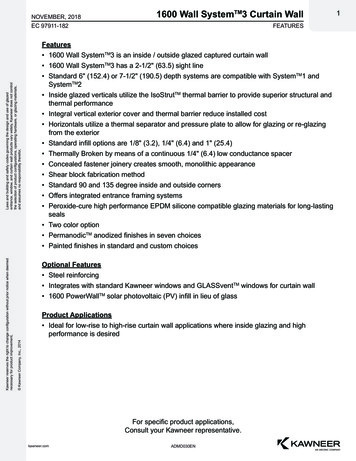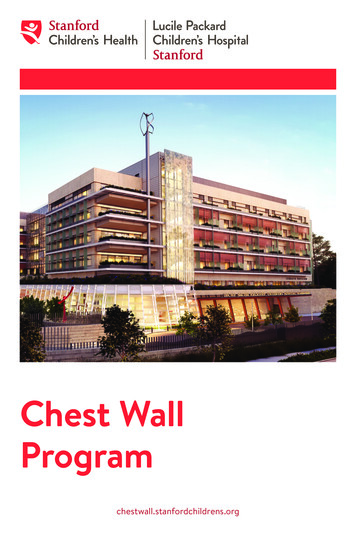
Transcription
Chest WallProgramchestwall.stanfordchildrens.org
2 Chest Wall Program
OverviewThe chest wall program at Stanford Children’s Health is designed to evaluateand treat children and adolescents with chest wall deformities, includingpectus excavatum, pectus carinatum and other chest wall anomalies. Manyof these deformities are frequently noticed during puberty but may presentmuch earlier in childhood. Our multidisciplinary team of pediatric surgeons,nurse practitioners, and staff will provide your child with a complete evaluationand treatment, as well as follow-up plans. Our goal is to help your childachieve the optimal function and cosmetic outcome for his or her chest wallabnormality. We recognize that each patient’s needs are unique and we workwith every child and his/her family to establish a customized treatment plan.Our Care TeamOur care team includes an expert team of surgical professionals who take acompassionate, family-centered approach to care. Our team cares for eachchild in collaboration with other health care professionals, the child and thefamily. We believe this team approach leads to the best outcomes for thechildren we treat.chestwall.stanfordchildrens.org 3
PectusCarinatumAlso called “pigeonchest,” is a deformity ofthe chest characterizedby a protrusion of thesternum and ribs.It occursmore often in boys andtypically becomes morepronounced duringearly adolescence.Pectus Carinatum
EvaluationYour child will meet with our team at the Stanford Chest Wall Clinic,where we will obtain a complete medical history and perform aphysical exam. We will also perform 3D mapping of your child’s chestwall during the clinic appointment and may recommend additionaldiagnostic testing.TreatmentOne of the most common techniques used to address pectus carinatumis a nonsurgical bracing system that gradually decreases the degreeof bony protrusion on the chest. This is accomplished with a speciallyfitted compression brace, which fits around the circumference of thechest and applies gentle pressure to reshape the chest over time.The success of bracing is directly related to the amount of time yourchild wears the brace. In the initial period, we recommend he or shewear it for 16 to 20 hours a day. We will regularly evaluate your child inthe clinic to follow his or her progress and adjust the bracing regimenas necessary.Your child will be provided with a prescription for his or her customdesigned brace. A list of orthotics agencies we partner with hasbeen provided for you.Surgical correction is an option for severe cases or for cases wherebracing has failed.Pectus Carinatum bracechestwall.stanfordchildrens.org 5
PectusExcavatumAlso referred to as “sunkenchest,” is a depression in thechest wall. The depression maybe in the center of the chest,or it may be more pronouncedon one side. A child can beborn with pectus excavatum,or he or she may develop thecondition during the pubertalgrowth spurt. The condition maybecome more severe or apparentduring periods of rapid growth.Early evaluation by a pediatricsurgeon during the pre-pubertalperiod can help families gainan understanding of what toexpect as their child maturesand provide guidance as towhether intervention is optimal.RibsSternumHeartRightlungLeftlungPectus Excavatum cross section
EvaluationWe will obtain a complete medical history and perform a physicalexam when your child meets our team at the Stanford Chest WallClinic. We may then recommend additional diagnostic testing to bestprepare your child for the most appropriate intervention that fits his orher individual needs. These diagnostic tests may include the following: X-ray, MRI or CT scanof the chest Echocardiogram Pulmonary function testingIn-office 3D imagingof the chest wall Allergy patch testingOnce the work-up is complete, we will review with you the best optionsfor your child. These may include the options discussed below.TreatmentsVacuum bellMild to moderate pectus excavatum may be improved by a focusedexercise regimen, a vacuum bell treatment or both. The vacuum bellis a nonsurgical treatment option for patients with mild to moderatepectus excavatum. While this procedure is nonsurgical, it shouldbe used under the supervision of our care team. The vacuum bellis fitted to each patient so it sits comfortably on the chest. A bulbattached to the device generates negative pressure to create avacuum, which raises the sternum over time. The vacuum bell must beHeartRightlungNormal cross sectionLeftlungVacuum bellchestwall.stanfordchildrens.org 7
applied at regular intervals, ideally for up to two hours each session twicedaily. The vacuum slowly pulls up the depressed area of cartilage. It maytake several months of use to reach the maximum correction, and it mayrequire up to two years of regular use to ensure a durable correction.Nuss procedureThe most commonly performed surgical treatment for pectus excavatum isthe Nuss procedure. During this minimally invasive surgical procedure,small incisions are made on each side of the chest so the surgeon can inserta metal support bar underneath the sternum to reverse the depression inthe chest. Minimally invasive surgical techniques strive to minimize bloodloss and operating times and can lead to a smoother, faster recovery.ALowest pointof rNuss Procedure (images A, B, C and D)8 Chest Wall Program
The bar is typically left in place for two to four years. Early bar removal canresult in recurrence of the depression.Bar removalThe procedure to remove the bar can be completed on an outpatient basisunder general anesthesia.Open procedure (Modified Ravitch procedure)In certain rare cases, correction of pectus excavatum (and/or pectuscarinatum) can be performed via a more invasive open surgical procedure.This technique involves an incision across the chest, excision of all deformedcostal (rib) cartilages, and correction of the sternum. This option is availableto patients with special ungLeftlungLeftlungBar flippedBar insertedDFinal placement ofbar and s.org 9
Preparing for SurgeryBefore surgeryOnce your child’s surgery is scheduled, you will be provided with specificinformation about when and where to arrive for surgery. Our anesthesiadepartment will contact you to discuss your child’s anesthetic plan and answerany questions you may have. Your child will be given an incentive spirometer (adevice which is used to help keep the lungs healthy after surgery) to practicedeep-breathing exercises prior to surgery. You will be given instructions foryour child to start a gentle laxative regimen the day before his or her surgery tohelp prevent any discomfort he or she may experience due to post-operativeconstipation. You will also be given antiseptic wipes to clean your child’s chestthe night before and the morning of surgery to help reduce the risk of infection.The hospital stayFor most pectus excavatum or pectus carinatum surgical repairs, patients shouldexpect to stay in the hospital for four to seven days. Patients will be able to eatand move around immediately after surgery. During your child’s hospital stay, ourcare goals will be to: Optimize pain control Work with physical therapy todevelop strategies to transfer yourchild and help him or her movearound comfortably Monitor the incisions to ensureproper healing Encourage your child to practicetaking deep breaths using theincentive spirometer to help fullyre-expand the lungs after surgeryand prevent fluid or mucus buildup that could lead to the development of pneumoniaReturning home and follow-upYour child will be discharged to your home once his or her pain is well controlledand he or she can move around independently. Your child will be providedwith exercises to help aid in his or her recovery at home. There will be minimalcare required for your child’s incisions. We will typically ask to see your childfor follow-up visits one month, three months, six months and one year afterdischarge. We will then arrange for a follow-up visit two years after surgeryto evaluate your child’s progress and discuss optimal timing for bar removal.chestwall.stanfordchildrens.org 11
Frequently Asked Questions1. What steps do I need to take to have my child evaluated in thePackard Children’s Chest Wall Clinic?Your primary care provider can make a referral to our clinic for evaluation.You can also call our surgery office directly and ask to speak with our staff toschedule an appointment. We recommend you bring the following with you tothe appointment:New patient evaluation formHIPAA consent/acknowledgement formCopy of insurance card2. How long does it take to complete any pre-operative testing?Depending on the tests ordered, it may take one to two months.3. Can any radiologic or allergy testing be done outside of Packard Children’s?Ideally, we would like our radiology service and allergists to be involved in theevaluation. However, we realize this is not always possible due to insurance orthe family’s distance from the hospital. We recommend all images and reportsof studies be sent directly to our pediatric surgery office:Department of Pediatric Surgery300 Pasteur DrAlway Building, M116Stanford, CA 94305-5733Remember that metal allergy testing may require certain panelsthat we can help clarify. Often, your child will undergo testing andthen return to the allergist’s office a few days later for interpretation.3. What is the typical age for the Nuss procedure?For optimal results, the Nuss procedure is typically offered during earlyadolescence, but it can even be performed with excellent results in adults.Each patient is evaluated on an individual basis to determine a treatment planthat best suits his or her needs.4. Is surgery urgent?Surgical correction with the Nuss procedure is never an emergency. This isa procedure that must be planned. Take your time, and prepare your familyand your child for the procedure.12 Chest Wall Program
Other Rare Conditionsof the Chest WallChest wall anomalies include a broad spectrum of congenital conditions.All of these deformities should be evaluated by a pediatric surgeon.Some may require immediate repair while others may simply need to beobserved over time. Examples of rare anomalies of the chest wall include:Poland syndromeThis syndrome affects approximately 1 out of 30,000 births. It can includethe following abnormalities: Absence of part or all of the muscles of the chest wall (pectoralis major,pectoralis minor, serratus anterior, rectus abdominus, latissimus dorsi) Absence of breast tissue or nipple defomities Fusion (syndactyly) or shortening (brachydactyly) of the fingers and toes Absence of axillary hair and a limited fat layer under the skinSternal cleftThis is a rare deformity that can be associated with congenital cardiacdefects and abdominal wall defects. A sternal cleft is a gap in the sternum(breastbone) that can span part or the entire length of the bone. The gap inthe sternum may impair breathing and can also result in decreased protectionof the underlying organs, such as the heart and lungs.chestwall.stanfordchildrens.org 13
Travel InformationWe recognize that many of our patients must travel significant distances toreach us. If you need to make travel arrangements for your child’s hospitalstay, Lucile Packard Children’s Hospital Stanford has a Housing Office thathelps out-of-town families arrange accommodations near the hospital. TheHousing Office works directly with each child’s family to ensure they havebest possible accommodations. When families contact the Housing Office,they are provided with information about possible housing options, whichmay include:Ronald McDonald HouseRonald McDonald House at Stanford provides a “home-away-fromhome” and offers support for the families of children with life-threateningillnesses who are receiving treatment at Lucile Packard Children’s HospitalStanford. Ronald McDonald House is a haven these families can call home,allowing them to give complete attention and support to their ill child.Corporate ApartmentsThere are a few local corporate apartments that provide a discounteddaily rate to families whose children are receiving treatment at LucilePackard Children’s Hospital.Lodging information and placement services are available whether yourfamily needs a single night of lodging or many months. Please contact theHousing Office at (650) 498-7971 for assistance.Lucile Packard Children’s Hospital StanfordHousing Office700 Welch Rd, Ste 114-BPalo Alto, CA 94304Tel (650) 498-7971Fax (650) 498-8007Hours of OperationMonday – Friday9:00 a.m. – 6:30 p.m.14 Chest Wall Program
Noteschestwall.stanfordchildrens.org 15
Marin028959 04/2017Contra CostaCPMCSan FranciscoSan FranciscoAlamedaSan MateoLucile Packard Children’sHospital StanfordSan JoseLos GatosSanta ClaraSanta CruzLocationsAt Stanford Children’s Health, we strive to provide world-class care in theneighborhood where you live. To better serve our patients, we have cliniclocations throughout the San Francisco Bay Area.Stanford Children’s Health– Los GatosPediatric General Surgery14601 S. Bascom Ave, Ste 200Tel (650) 723-6439Fax (650) 724-5344California Pacific Medical Center– California CampusPediatric General Surgery3801 Sacramento StSan Francisco, CA 94118Tel (415) 386-2749Santa Clara Valley Medical CenterPediatric General Surgery751 S Bascom AveSan Jose, CA 95128Tel (408) 885-5940Lucile Packard Children’sHospital StanfordPediatric General Surgery730 Welch Rd, 2nd floorPalo Alto, CA 94304Tel (650) 723-6439Fax (650) 724-5344Please recycle.
Absence of axillary hair and a limited fat layer under the skin Sternal cleft This is a rare deformity that can be associated with congenital cardiac defects and abdominal wall defects. A sternal cleft is a gap in the sternum (breastbone) that can span part or the entire length of the bone. The gap in

